The US has more turtle species than any other country in the world. Among those species, some are native to Massachusetts. Some are aquatic, but others are terrestrial. It is worth noting that there is no sea turtle native to Massachusetts.
So, how many turtle species are native to Massachusetts?
There are 11 turtle species in Massachusetts, and they are;
- Blanding’s turtle
- Eastern Musk
- Eastern Box
- Eastern Painted
- Common Snapping
- Northern Diamondback Terrapin
- Bog Turtle
- Northern Red-bellied Cooter
- North American Wood Turtle
- Spotted Turtle
- Red-eared Slider
Out of these species, ten are native to Massachusetts, while one is a non-native species. In terms of conservation, 6 of them are listed as endangered, with their main threats being road mortality and encroachment of their habitats.
Now, let’s have a detailed look at features that distinguish these species, how they reproduce and other features of these turtles.
1. Blanding’s Turtle
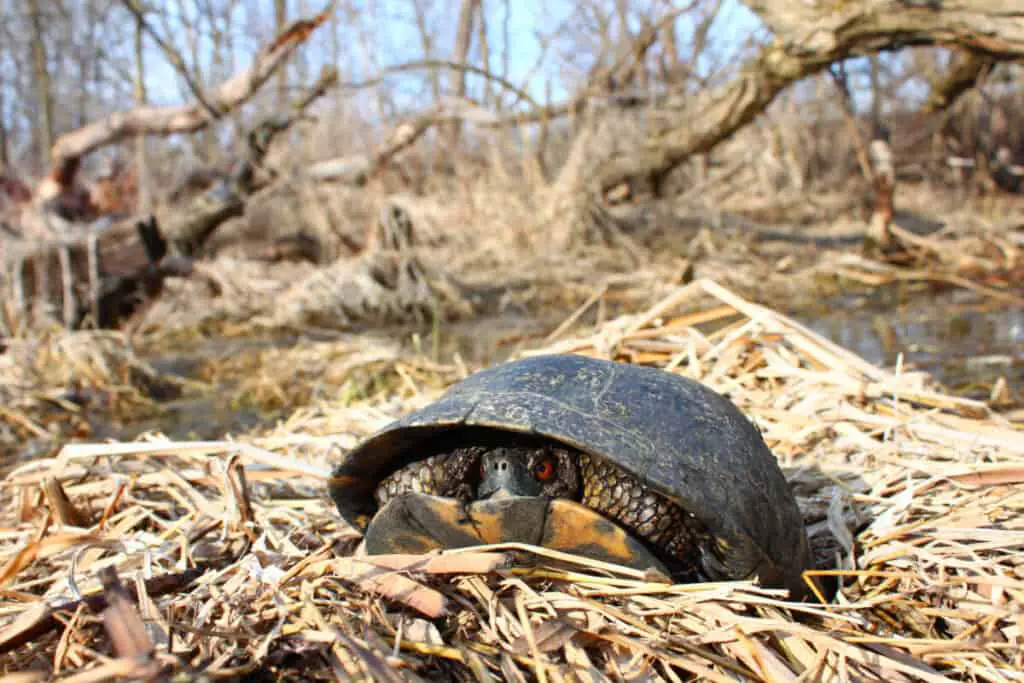
To start us off is this turtle species with the scientific name Emydoidea blandigii. They have a smooth carapace whose color is either dark brown or black and also has yellow spots. The plastron ranges from black to yellow with a variety of patterns. Its most common patterns are black spots on the scutes.
Blanding’s turtles expected lifespan is 70 years. They feed on an omnivore’s diet that mainly includes other insects, fish eggs, snails, frogs, small fish, seeds, and plants. More mature Blanding’s turtles feed on a more carnivorous diet.
The species is semi-aquatic, mainly inhabiting shallow wetland areas with abundant aquatic vegetation and grasslands or savanna. They opt for temporary wetlands to avoid predators often found in permanent ones. In summer, they hide in the grasslands and during winter, they hide in ponds, marshes, bogs, creeks and other shallow waters.
On average, females attain sexual maturity at 18 years while males do so much earlier, at about 12 years. Breeding often takes place between March and April.
The females lay eggs in bare soil with no vegetation, such as roadsides and trail edges, to ensure that the area is not frequented by predators in search of food. Unfortunately, some females are killed while nesting in these roadside areas and nests are destroyed during road constructions. On average, a clutch carries 11 eggs, and the incubation process takes 80 – 128 days.
They are some of the most threatened turtle species in the northeastern US. They are listed as endangered and protected under Massachusetts regulations.
2. Eastern Box Turtle
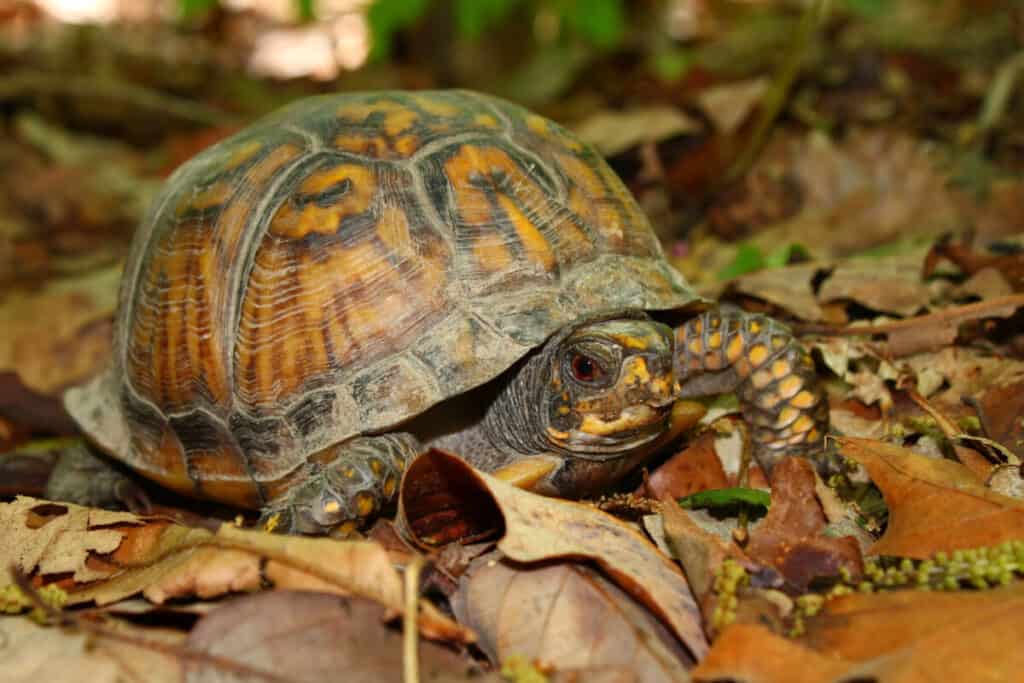
Eastern box turtles have a brown or black dome-shaped shell. In addition, a unique feature is that both the shell and skin have a similar pattern with a lot of blobs colored in either orange, red or yellow. The design of the blobs or spots varies from one individual to the other. Their scientific name is Terrapene calorina calorina.
The term box turtle comes from their ability to fully retract their head, limbs, and tail into their shell and close tightly. Their plastron is hinged at the posterior and back which is why they are able to close completely.
Like with other box turtles, the Eastern box turtle is land-dwelling. They inhabit open woodlands, meadows as well as grasslands. These turtles have a medium size measuring 5-7 inches when fully grown, while their hatchlings measure about 1.25 inches.
Eastern box turtles feed on an omnivorous diet. They feed on pretty much anything they can find, from fruits, insects, meat, to any type of vegetation. When mature, they feed on a more plant-based diet while juveniles eat more animal protein.
They live for between 30 and 50 years in the wild but have the potential to live for up to 100 years.
They attain reproductive maturity at about 5 years old. Nesting occurs from May to July and breeding will have taken place between April and October. The incubation process takes an average of 75 days. The sex of this turtle species, and all other turtles, depends on the moisture and temperature level in the hatching place.
Eastern box turtles are vulnerable species in Massachusetts.
3. Eastern Musk Turtle
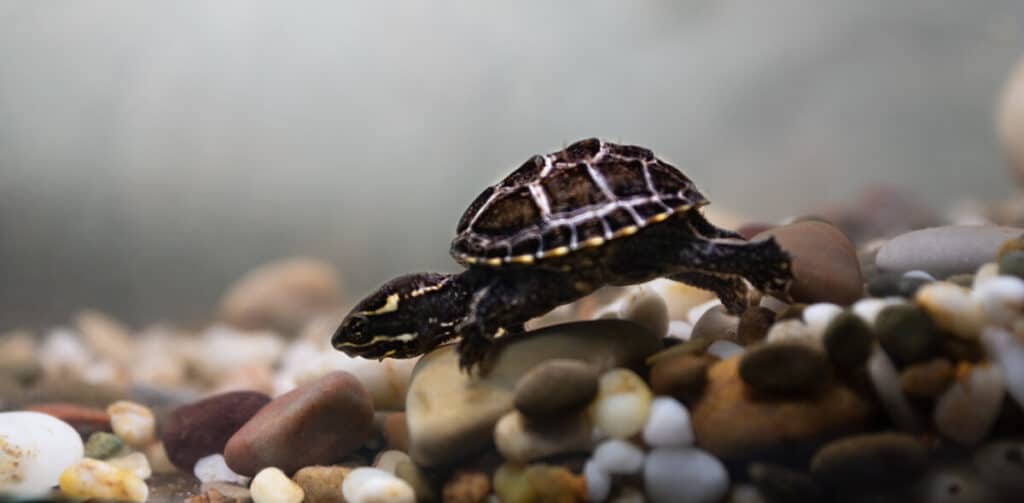
In scientific terms, referred to as Sternotherus odoratus, this turtle species also has other names like common musk turtle and stinkpot. The term stinkpot and odoratus in Latin comes from the strong musky scent it emits as a defense mechanism.
It features a slim dome-shaped carapace which brown colored and black blotching often hidden by algae or mud. Eastern musk’s feet and head dark brown or black and mature ones have a light line below and above each eye. Its plastron is light-colored, often yellow to brown and only has an anterior hinge. This means that the plastron only closes at the front.
They live in an aquatic habitat, often living in rivers and lakes. Unlike most turtles who bask on rocks or floating logs, eastern musk species bask beneath floating vegetation. Surprisingly, they are good climbers even on tall trees.
These musk turtles feed on a primarily carnivorous diet, and their food includes tadpoles, carrions, invertebrates, tiny snails, aquatic insects, fish eggs, and minnows.
Eastern musk turtles hardly grow, only measuring between 2 and 4.5 inches when mature, while their hatchlings measure slightly below 0.8 inches.
Within 3-4 years after hatching, most eastern box turtles will have reached sexual maturity making them one of the turtles in Massachusetts that start reproducing at a young age. They nest between May and July at a distance not exceeding 50 meters from the water. At times, they nest in open grounds and on other occasions beneath logs.
4. Eastern Painted Turtle
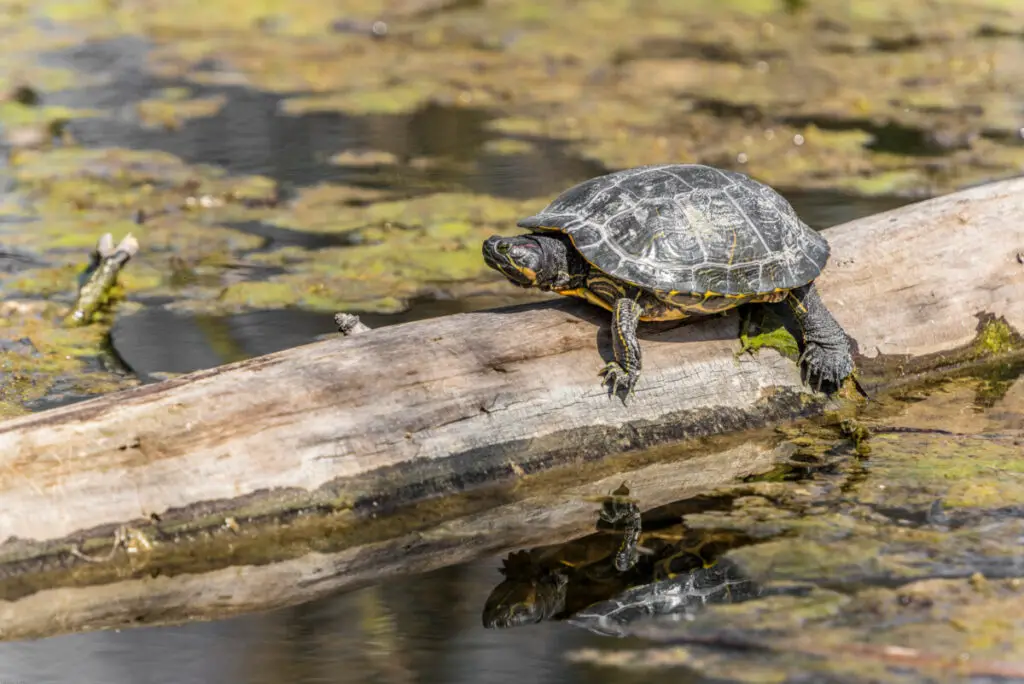
The scientific name for the Eastern painted turtle is Chrysemys picta. They are common in the wetlands throughout Massachusetts. These turtles are medium-sized, measuring between 5.5 and 6 inches. They have a smooth, slightly-domed and unkeeled carapace.
The carapace is usually olive, green or black with red or orange markings on the edges. Its head, neck and limbs are black or olive with conspicuous yellow or red markings. The plastron is bright yellow or orange.
Eastern Painted turtles are common in shallow, slow-moving waters with muddy bottoms such as lakes, streams and ponds. Their habitats are characterized by rock banks as these turtles are fond of spending time in the sun. They can bask for over 6 hours each day.
Painted turtles are omnivores, and their diet comprises mollusks, crayfish, invertebrates, carrion, algae and aquatic vegetation. They hibernate under the mud at the bottom of the lakes till late March or early April.
They have an expected lifespan of between 20 and 25 years.
A male painted turtle takes about two to four years to mature sexually, while a female takes between four and nine years. Nesting in painted turtles happens between May to early July.
A female looks for the bare ground which has access to sunlight and lays her eggs. The warmth from the sun aid the incubation and determination of the gender of the hatchlings. On average, a clutch size for these turtles has between 4 and 10 eggs.
Incubation takes between 70 and 100 days. The hatchlings start emerging by early September through October. At times, the hatchlings may remain in the nest cavity to overwinter until early spring.
5. Common Snapping Turtle
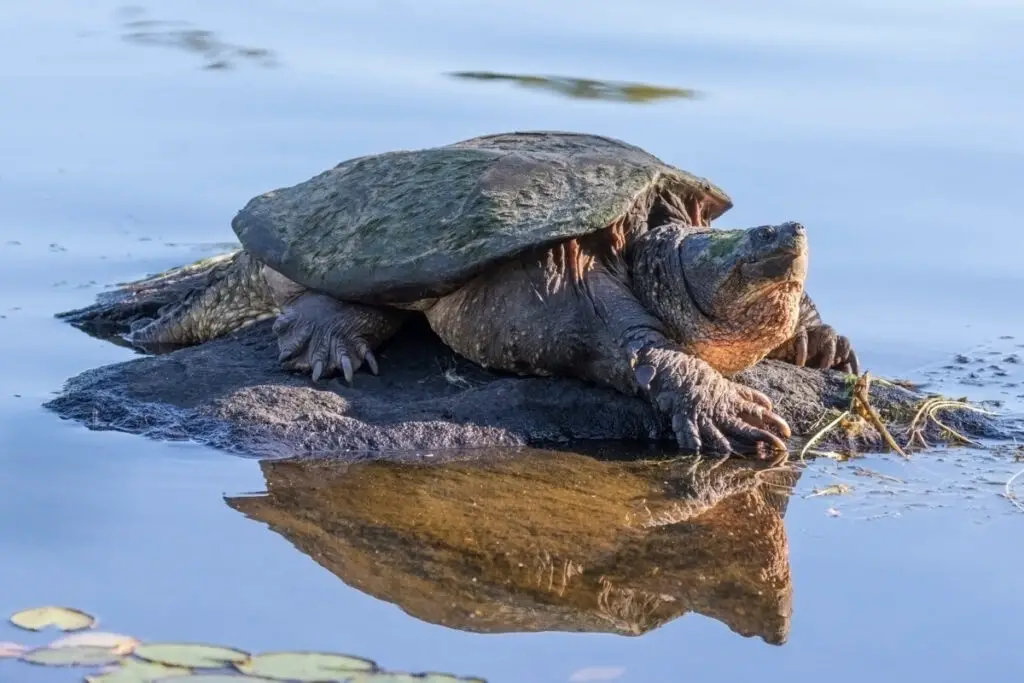
There are mainly two main species of snapping turtles, common snappers, Chelydra serpentina, and alligator snappers, Macrochelys temminckii. They are both freshwater turtles. One of the differences between the two is that a common snapping turtle has long limbs and a neck, while an alligator snapping turtle has a short neck that is almost fixed to the neck.
Common snapping turtles are among some of the largest turtle species in the world. An adult turtle can grow between 9.5 and 19 inches long and may weigh up to 16kgs. Due to their neck’s length and strong jaws, these turtles can cause serious harm if not carefully handled. They have powerful bites.
These turtles have a strong build with rugged carapaces and strong limbs and necks. The color of the shell ranges from brown to tan and, at times, black. As they age, the shells accumulate algae and mud. Just like their shells, their tail is rugged and covered with sharp ridges. The skin has a brown color, same as the plastron but with tubercles (bump-like structures) all over its necks and limbs.
Snapping turtles are omnivores and mainly feed on invertebrates, small fish, birds, reptiles, carrion, small mammals and vegetation. Due to their slow nature, they rarely actively hunt for prey and will lay in wait or hunt for dead or dying prey.
They are common in most freshwater bodies with soft bottoms and an abundance of aquatic vegetation. Tiny snapping turtles may also be spotted swimming in streams.
Sexual maturity in snapping turtles occurs between 8 and 12 years or when a turtle is 12 inches long. Males, however, mature faster than females. Reproduction in common snapping turtles happens between April and November.
Eggs are laid by July, about 25-40 eggs in a clutch. The eggs take between 70 to 100 days to hatch. It is worth noting that females are able to hold sperms in their bodies, waiting for a suitable time for fertilization.
While these turtles are not classified as endangered or threatened, their numbers have significantly decreased due to habitat destruction.
For those wishing to have these turtles as pets, you need to have excellent skills in handling turtles. Snapping turtles are one of the most aggressive turtles, and poor handling may result in severe injuries through bites and scratches.
6. Diamondback Terrapin
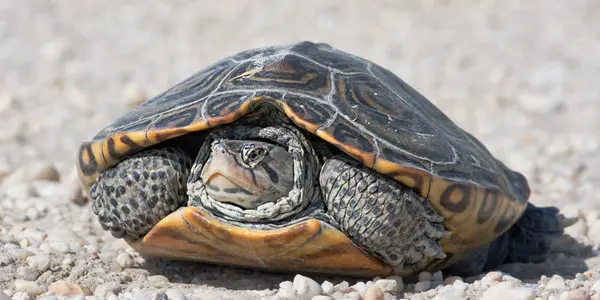
As it is biologically referred to, Malaclemys terrapin is the only North American turtle species that inhabits dark waters located at the meeting point of fresh and salty ocean waters. It gets its name from the diamond shapes on its upper shell (carapace).
Diamond terrapin’s shell color varies between with the carapace being grey, black or brown while the plastron is greenish. It also has ridges, and the upper part has a wedge-like shape, and the back part is wider than the front.
Their skin is greyish to black and is spotted with flecks of a dark green color. Their upper and lower jaws have a light color. Its hind limbs are huge and paddle-like besides being heavily webbed.
Diamond terrapins only live in salty marshes along the coast, brackish water ditches and tidal creeks. They are known to inhabit the same territory year after year. In terms of size, they are medium-sized, with the females growing to between 6 and 9 inches while males are smaller at 4 to 6 inches big.
Female Diamondback terrapins lay eggs between June and July. Hatching takes an average of 70 days, and new hatchlings measure one inch long. When the hatchling emerges, they remain on the grassland areas until they are around four years old and move to the marshes.
This turtle species was largely hunted as a delicacy in the nineteenth century, and consequently, it almost became extinct. Although hunting has significantly reduced, it still faces the illegal pet trade, increases in salty marshes, flooding, sea-level rise, road mortality and habitat destruction. Cape Cod is the most affected.
The diamondback terrain is categorized as a threatened species in Massachusetts.
7. Bog Turtles
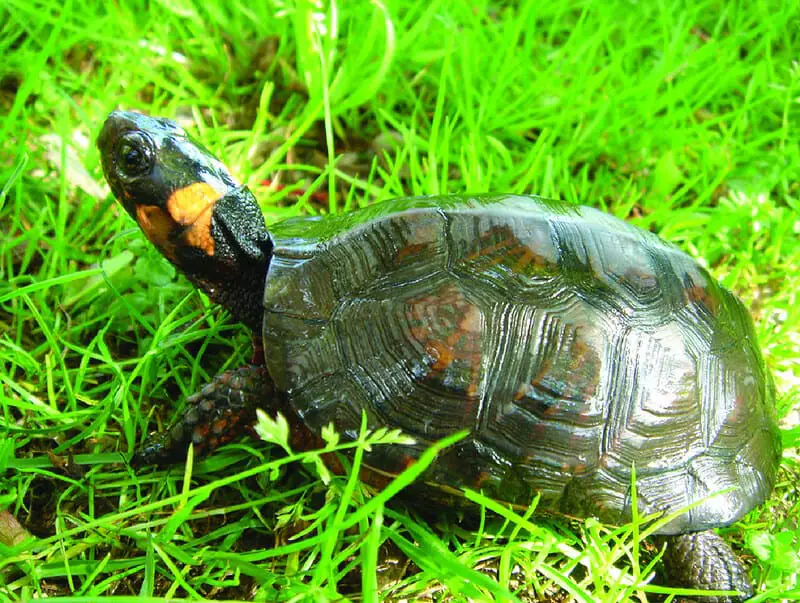
The scientific name for this turtle is Glyptemys muhlenbergii.
It is a small turtle with beautiful patterns on its carapace. Due to this, they are usually hunted and sold in the black market as pets. This has led to their numbers dwindling, and they are currently classified as “critically endangered”.
They have a bright yellow patch on each side of their heads. Sometimes, these two patches join to form one continuous yellow patch. The carapace is dark and has scutes with a reddish or yellowish hue with a slight vertebral keel that disappears with age.
Bog turtles are among the smallest of all aquatic turtles, only achieving a mature height of just 3 to 3.5 inches. Males turtles have a flatter carapace than the females, while their plastron is concave to aid in mating. Their tales are also thicker than those of the female turtles.
They prefer habitats consisting of wetlands with calcium carbonate or lime. Such habitats include; wet pastures, wet meadows and sphagnum bogs. These turtles rely primarily on vegetation and a grassy environment with high humidity.
This turtle species that stay small is omnivorous, with its diet consisting of fruits, berries, slugs, insects, worms, crayfish, snakes, frogs and carrion.
Bog turtles breed between April and September, and the eggs are laid between April and July. A female turtle will lay between 2 and 5 eggs, often in the sunny parts of a bog. Incubation then commences and takes about 50 to 65 days. Maturity in bog turtles takes about 9 to 15 years, while their lifecycle is about years.
Due to their threatened numbers, bog turtles are critically endangered, and thus one is not allowed to keep them as pets. It is also illegal to pick a turtle from the wild and keep it as a pet. In Massachusetts, in the event you spot a bog turtle, you should call the authorities to take the turtle away.
8. Northern Red-bellied Cooter
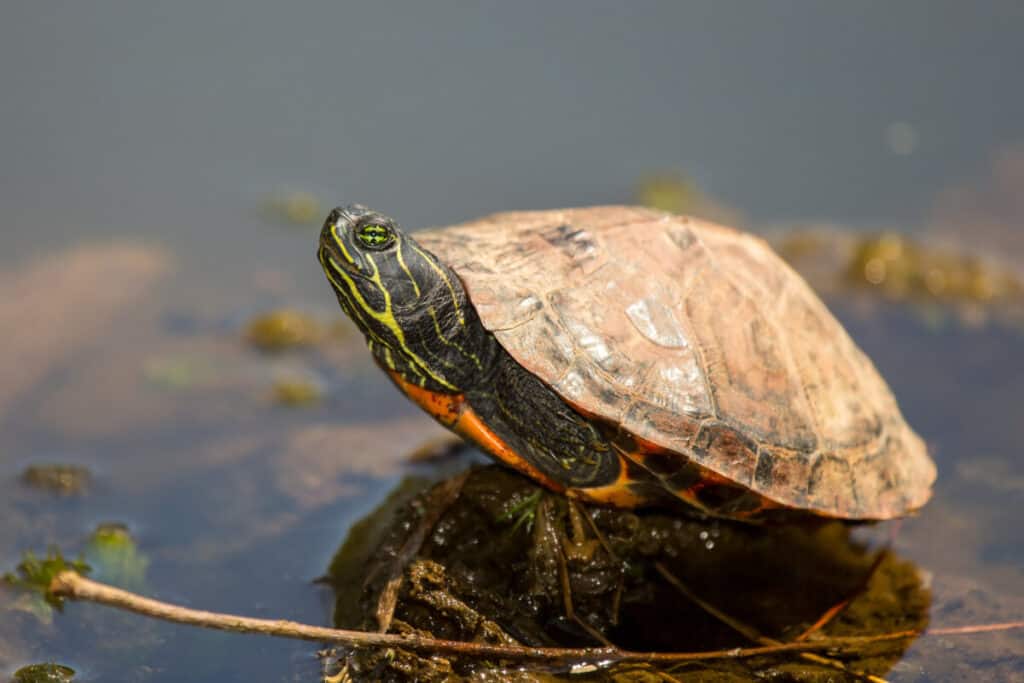
These turtles are scientifically known as Pseudemys rubriventris. Their carapace is highly domed and varies in color from brown to black. As the name suggests, their belly or plastron has a distinctive reddish color.
Towards the rear edges of the carapace, this turtle has reddish-orange patches. There are also reddish stripes across the middle scutes. The turtle’s skin and neck have a dark color with bright yellowish stripes. A mature cooter turtle has a length of between 5 and 12 inches.
In Massachusetts, Red-bellied cooter turtles are found in shallow, slow-flowing water bodies like rivers, streams, marshes, and ponds. They also prefer rocky banks as they are fond of basking in the sun.
Being herbivores, cooter turtles will prefer areas with lots of vegetation for easier access to food. Their diet mainly consists of tadpoles, worms, snails, crayfish, larvae, algae and other aquatic plants. The main predators that cooter turtles face include skunks, crows, bullfrogs, and herons.
Breeding in cooter turtles happens between May and September. A female turtle will lay one or two clutches in a year, each containing 10 and 20 eggs. The incubation period in these turtles takes between 70 and 90 days. The lifespan of red-bellied cooters is, on average, about 50 years.
Red-bellied cooter turtles are classified as endangered turtles. As such, it is illegal to hunt, keep, own, or sell these turtles.
9. North American Wood Turtle
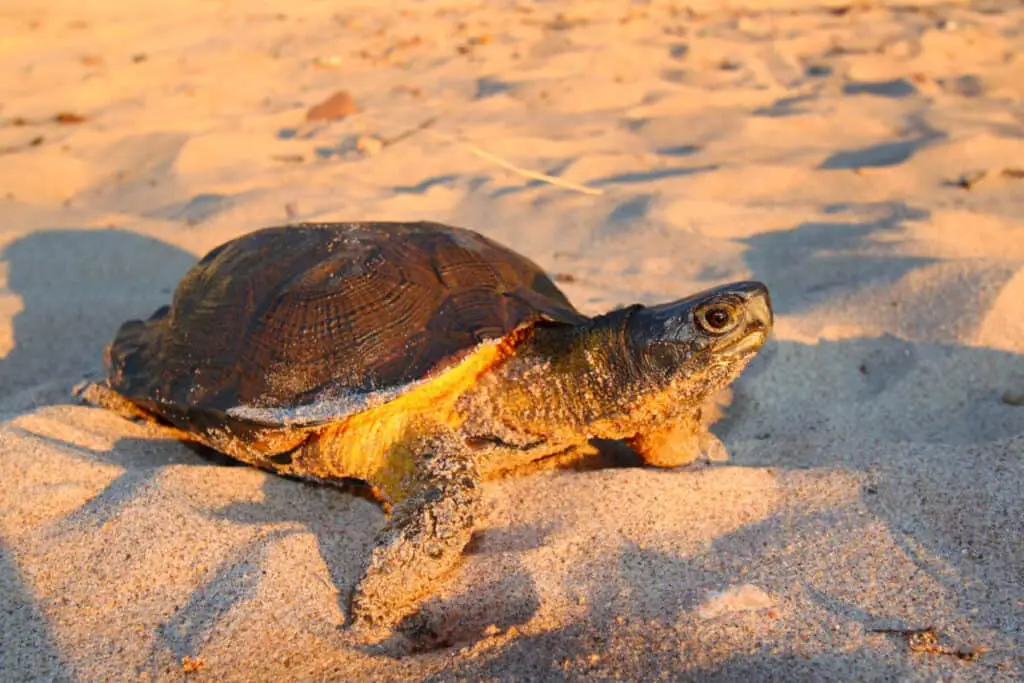
The biological name of a wood turtle is Glyptemys insculpta. Under MESA, these turtles are placed under special concern status. They are medium-sized turtles measuring between 5.5 and 8 inches.
The carapace is brown, tan or greyish-brown with a vertebral keel. It is also rough, and each scute has a pyramid-like shape that rises in the center. Their scutes have groves and ridges that resemble growth rings in wood hence their name. The plastron has a yellow or sometimes orange color with oblong dark patches on the edges.
Their skin is rough and has an orange color with dark patches, especially on the limbs. The head of a wood turtle is black but with some orange color on the lower part toward the neck.
Wood turtles are widespread in Massachusetts, but very few turtles have been spotted. Its main habitat is riparian land. They are common in slow-moving water bodies like streams, ponds and rivers with soft. Further, they prefer habitats with dense vegetation for cover and food.
Open river banks with loose sand or gravel are used as hibernating grounds. When active, wood turtles are present in bogs, wet meadows, deciduous forests, wetlands, riparian lands and other areas that are wet with dense vegetation. It is from here that they get most of their food. They, however, do not stray too far from a water source. The farthest they can go is just a few hundred meters.
Wood turtles are primarily opportunistic omnivores. They feed on aquatic vegetation, algae, invertebrates, worms, insects, small fishes, crayfish and other small aquatic animals.
One of their ingenious hunting tactics is “stomping”. Here, they use their limbs to stomp on the ground creating vibrations that mimic the rain. This tricks earthworms to come to the surface to escape drowning, only to be promptly devoured by the turtle.
The lifespan of a wood turtle is about 50 years, but there are records of turtles that have lived up to 100 years.
Reproduction in wood turtles starts in May and ends in early September. A female turtle lays a clutch with seven eggs on average. Incubation then takes 70 to 90 days, depending on the conditions of the nest.
Wood turtles are at the risk of becoming endangered owing to human activities in their habitat. Also, wood turtles are highly commercialized due to their attractive patterns and small size. It is illegal to both sell a possess a wood turtle in Massachusetts.
10. Spotted Turtle
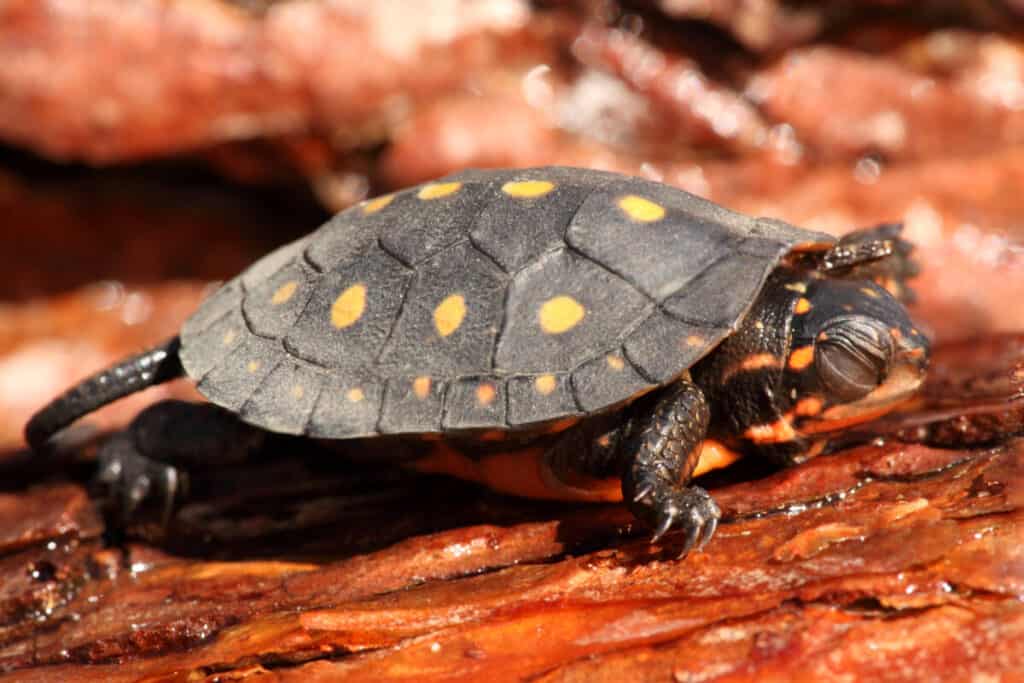
A spotted turtle, Clemmys guttata, is a small-sized, semi-aquatic turtle with a smooth shell. They grow to about 5 inches in carapace length. Its carapace is either grey or black with brightly colored yellow spots that commonly disappear with age. The lower shell (plastron) is yellow with large black patches.
The turtle has yellow, orange or red skin with dark patches while it’s head is black but with several yellow blotches. The lower surface of the turtle’s limbs is pink or reddish color. Male and female turtles differ in both coloring and sizes.
A male spotted turtle has a tan, black or brown chin and brown eyes with a thicker tail, while its female counterpart has a yellow or orange chin with orange eyes and a narrower tail.
Being semi-aquatic, spotted turtles spend their lives on both land and water. They prefer slow-moving and shallow water bodies like bogs, marshes, streams, and small unpolluted rivers with dense aquatic vegetation.
Spotted turtles are omnivores and will feed on algae, water lily seeds, aquatic plants, amphibians, larvae, mollusks, slugs, crustaceans, amphibian eggs and carrion. Their main predators are raccoons and muskrats. When threatened, painted turtles will either bury themselves in the mud or slide into the water.
Sexual maturity in spotted turtles occurs by the age of 14, with males maturing earlier than females. Reproduction starts by mating between the months of March and April. Females then lay one clutch of eggs in May, containing about 1 and 8 eggs.
Incubation takes between 40 and 90 days. Hatchlings start emerging towards the end of August and early September. The lifespan of spotted turtles is about 65 years in males and 110 years in females.
Massachusetts Endangered Species Act had classified spotted turtles in the special concern list. In 2006 however, they were removed from the list owing to an extensive distribution in the state and relatively stable populations in Southeast Massachusetts. They are uncommon but not rare in the state. Owning spotted turtle pets was legalized in Massachusetts after the 2006 delisting.
11. Red-eared Slider
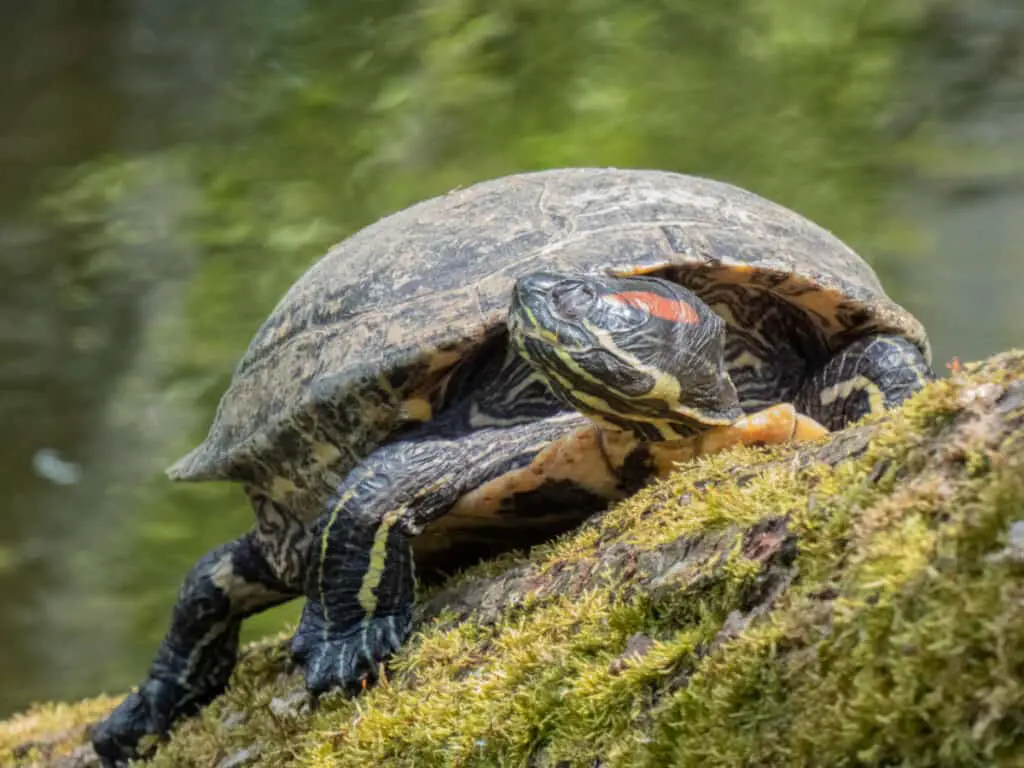
Scientifically, these turtles are called Trachemys scripta elegans. Their name is derived from two distinct red stripes behind each of the turtle’s eyes. They are medium-sized turtles with mature ones achieving up to 12 inches in carapace length.
The red-eared slider is similar to the painted turtles, safe for the red marks and a highly domed carapace. Their carapace has a dark olive-green or black color while the plastron is yellow. Towards the edges, the carapace has yellow lines.
They have greyish skin on the neck and limbs. These turtles also have a strong jaw for crushing prey.
Red-eared turtles are common in shallow, slow-flowing waters with rocky grounds as the turtles spend most of their time basking in the sun. They inhabit ponds, streams, rivers and marshes with soft bottoms. Being semi-aquatic, they also spend some of their time on land.
These turtles are known as sliders due to their characteristic behavior of sliding from their basking rocks back into the water. They are said to be one of the highly invasive turtle species and are common in the southeastern side of the US. In Massachusetts, they are common all over the state.
Red-eared sliders are omnivores and will feed on both vegetation and meat. Their diet consists of small fish, dead, aquatic vegetation and decaying animals like frogs and other invertebrates, crickets and earthworms.
Reproduction in red turtles occurs from April through September. A month after mating, a female turtle will lay between 2 and 24 eggs in a clutch. Depending on the temperature in the nest, incubation can take anything between 70 and 100 days.
Hatchlings will start emerging in early September. Males turtles will achieve sexual maturity earlier than females by the 3rd year, while in females, it occurs by the 5th year.
Red-eared sliders are non-native turtles in Massachusetts, and according to Massachusetts Endangered Species Act, MESA, they are not considered to be under threat.
Frequently Asked Questions
Let’s now look at some of your commonly asked questions regarding turtles in Massachusetts:
Which Turtles Are Not Listed in Massachusetts?
The non-listed turtle species are those that are not on the endangered turtle’s list in Massachusetts.
From the 11 turtle species native to Massachusetts, some are listed, but not all. They are the spotted turtle, eastern musk turtle, snapping and painted turtles and red-eared sliders. There are also not many limitations in Massachusetts on owning these non-listed turtles.
Which Are the Non-Native Turtles in Massachusetts?
Non-native means that this turtle was is not originally from Massachusetts but was introduced from other states.
Out of the 11 turtles explained in this article, only the Red-eared sliders are non-native to Massachusetts. The red-eared slider is actually better spread in the state than most non-native turtles. Most of them result from pet owners releasing them into the wild, which is not recommended.
Which Turtle Can You Own Legally in Massachusetts?
In Massachusetts, most native turtles are listed as endangered or of concern. As such, people are not allowed to own them as pets. There are only three turtles that one can have as pets.
The turtles you can legally own as pets in Massachusetts are common snapping, common musk, and painted turtles. For the rest, you will need to have a permit to own a turtle. Ownership of other turtles like the bog turtle is illegal, with or without a license.
Are Box Turtles Endangered in Massachusetts?
Yes, box turtles are an endangered species in Massachusetts, and there are several reasons for this. The main threat to box turtles populations in this state includes damage to their habitats because of industrial and residential developments, being killed while crossing roads, and illegal collection by people to keep them as pets.
Can You Collect Turtles from The Wild?
Just like owning turtles, it is illegal to collect or capture turtles from the wild. The only three turtles that one can capture and keep from the wild are common musk, painted turtles and the common snapping turtles. It is illegal to take the rest of the other turtle species from the wild and keep them or their shells.
How Many Turtles Can You Legally Own?
When it comes to the number of turtles you can have, one is only allowed to legally own two turtles for the painted and Common musk turtles while there is no limit to the snapping turtles.
Conclusion
We have seen the appearance, diet, reproduction process, expected lifespan, and other features of the different turtle species native to Massachusetts from the above list.
Of the turtle species in Massachusetts, the following are listed as endangered or of concern; Blanding’s turtles, Diamond terrapin, Northern Red-bellied cooter, Eastern box, Spotted turtle, and Wood turtle. The two main threats are the destruction of turtle habitats and breeding grounds by human activities and predation.
In Massachusetts, possession of endangered turtles is either restricted or illegal. As such, you need to familiarize yourself with the laws governing turtle possession before acquiring a turtle. If you spot an endangered turtle in the wild, you should contact the authorities and take it away.
Learn more about other turtle species:
- Turtles In Oklahoma (17 Species Guide)
- Turtles In Maryland (Full Guide With Pictures)
- Turtles In Alabama (30 Species with Pictures)
- Kentucky Native Turtles (17 Species With Pictures)
- Indiana Native Turtles (Ultimate Guide With Pictures)
- Michigan Native Turtles (10 Species with Pictures)
- 18 Native Turtles in Tennessee (Guide With Pictures)
- Florida Turtles Guide (Full Guide With Pictures)
- Turtles In South Carolina (20 Species With Pictures)